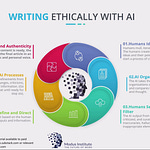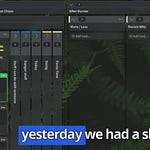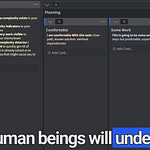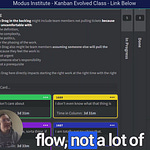Solopreneurs, microbusinesses, and those of us looking for new work face challenges are looking for progress. We need to balance creative passion with relentless administrative demands, unpredictable tech issues, and the emotional labor of client relationships. The video talks about solopreneurs, but it doesn’t take much of a stroll through LinkedIn to see that so many of us are also looking for work and that can be a lonely job in its own right.
This article builds on the video above, providing the structure and power of a Kanban board designed for solo business owners. I create not only a flow of work from yesterday’s video, but include an “Afterburner” column to make sure that our overwhelm isn’t in such control that we can improve our way out of it.
Each section below summarizes a major theme from the video and extends it with practical insights from the Modus Institute and Humane Work knowledge base.
Visualizing the 5Ps: Making our Real Work Visible
From the Video:
Our work isn’t just tasks, it should have some direction, it should have some structure. But for those working alone, it all feels like a deluge. Tasks, taxes, attacked by interruptions.
To bring calm to this, the video provides a Personal Kanban with five swim lanes: Process, Provision, Platform, People, and Personal. This structure makes visible the true landscape of solo work:
Process: The core flow of your business (content creation, service delivery, etc.).
Provision: The administrative overhead (taxes, compliance, and all the “must-dos” that are easy to procrastinate).
Platform: The tech and tools that support your work, including their (endless) maintenance and troubleshooting.
People: Clients, collaborators, and anyone you interact with, highlighting the importance of relationship management.
Personal: Your own well-being, energy, and growth.
Extension:
Overwhelm lives in the invisible. By mapping not just tasks but categories of expectation, you can instantly spot imbalances. You can see admin overload or neglected client follow-ups. You need to track these or you’ll lose them, using visual cues (colors, icons) to highlight urgent or neglected areas, and reviewing your board daily to rebalance your focus. Build your system, lose less, and feel progress.
Standard Work and Creative Flow
From the Video:
Standard work is repeatable routines for admin, tech setup, and daily tasks. It’s how you do the things you do. Having it frees up bandwidth for creative, high-value work. By making these routines explicit and easy to follow, we can reduce friction and decision fatigue. More importantly, we can better understand how much effort something is going to take and are better prepared for the eventuality that sometimes it does not.
Extension:
Standard work is not about rigidity or making you do the same thing every day. It is how you ensure that when you do things you know how you do them, what results you want, and how to improve them. When we create predictable space for work, we are also creating emotional space for the unpredictable. You know things are going to happen to knock you off your game, make sure your game is strong enough to resist those efforts. And when the weird does happen, you are able to respond elegantly.
In Personal Kanban and making work visual we want to see the routine parts of our day so we can respond flexibly to creative opportunities and unexpected challenges. Regularly review your routines in the “Process” lane to refine them for efficiency and ease. Then, use the afterburner, to fine tune.
Which brings us to the afterburner.
The Afterburner: Turning Completion Into Learning
Stuff from the Video:
The Afterburner is a place, a set of columns, were we can analyze completed work for quality, completeness, and satisfaction. Instead of simply moving tasks to “Done” and forgetting about them, we learn, we reflect:
Was this work up to your standards?
Did it energize or drain you?
What would you do differently next time?
(You can ask more questions than these three…what’s important to you?)
The afterburner in the video uses visual cues (smiley faces for wins, snakes for pain points) to make it easy to spot patterns, celebrate wins, and see our impact.
Extension:
The Afterburner reminds you that completed work isn’t “your past to be forgotten”. We want to constantly make our small business more successful and we can only doing that by doing more of the right things and less of the not-right things. We can only doing that by adjusting how we work, what we choose to spend our energy on, and how we respond to demands on our time.
This ensures your Personal Kanban is a work tool and a learning engine. Improvement is impossible without reflection. Setting aside time to reflect is good, but in the end it means you only reflect when it is time. Scheduled reflection is at best musing, but more likely it is time you cannibalize to do something other than reflect.
With the Afterburner and the emojis, reflection is happening constantly. You see and are reminded what you’ve done, how that relates to what you are doing, and allows you to routinely ask “What went well with that last time? What needed fixing?” and making those insights immediately actionable, you build a system of continuous, humane improvement. You review your Afterburner every time you touch your work. Learning will always be fresh.
Actionable Improvement: From Insight to Change
So, to be clear and really drive this point home, the Afterburner isn’t for idle reflection, it is for immediate action. When you spot a recurring pain point (like a tech tool that always fails), you can decide to research alternatives, seek advice, or automate the task. When you notice a satisfying project, you can plan to do more of that kind of work or with those nice people.
At Modus Institute, we think this real-time action is the heart of “visualized improvement.” Don’t let lessons learned fade into memory, wait weeks or months to discuss what went right, Do..It…Now. Turn these insights and inspirations into new cards, experiments, or changes to your standard work.
Share persistent challenges with your network; often, someone has already solved the problem you’re facing.
Close this up… Sustainable Solo Business
The video closes by urging solopreneurs to leave their business a little better each day, using the Afterburner to avoid repeating mistakes and to reinforce what works. Humane Work is about more than getting things done—it’s about making your work visible, manageable, and meaningful. By visualizing the full scope of your commitments, reflecting honestly on outcomes, and acting on what you learn, you create a resilient, adaptive solo business. This isn’t just hooey hustle culture; it’s sustainable progress, grounded in clarity and self-compassion. You started your business for a reason, remember it, respect it, and re-invigorate it.
Next Steps
Visualize your own 5Ps: Adapt the swim lanes to fit your unique business landscape.
Build your Afterburner: Make reflection and improvement a visible, regular practice.
Go deeper: Explore Modus Institute’s Cleaning Toxic Waste and Personal Kanban Evolved courses for hands-on tools and a supportive community.
Every day, make your learning visible. Every day, invest in making your business more humane. You seriously owe it to yourself and everyone you serve.










